Increased Disease Risk: Uranium Mining Near Aboriginal Areas
VerifiedAdded on 2023/06/10
|14
|4180
|378
Report
AI Summary
This report examines the environmental health issues arising from uranium mining near remote Aboriginal areas in Australia. It explores the historical context of uranium mining in Australia, focusing on the Northern Territory and the Kakadu region, and highlights the increased incidence of cancer and other diseases among Aboriginal populations. The report delves into the affected populations, including the Gunwinggu people of Oenpelli and communities near Jabiru, and reviews the current status of environmental health, addressing air and water pollution, asbestos exposure, and contamination of land and water. Challenges, obstacles, and controversies related to uranium mining are discussed, including the remoteness of communities and the impact of environmental exposures. The report concludes by emphasizing the need for further research and mitigation strategies to protect the health and well-being of Aboriginal communities affected by uranium mining.
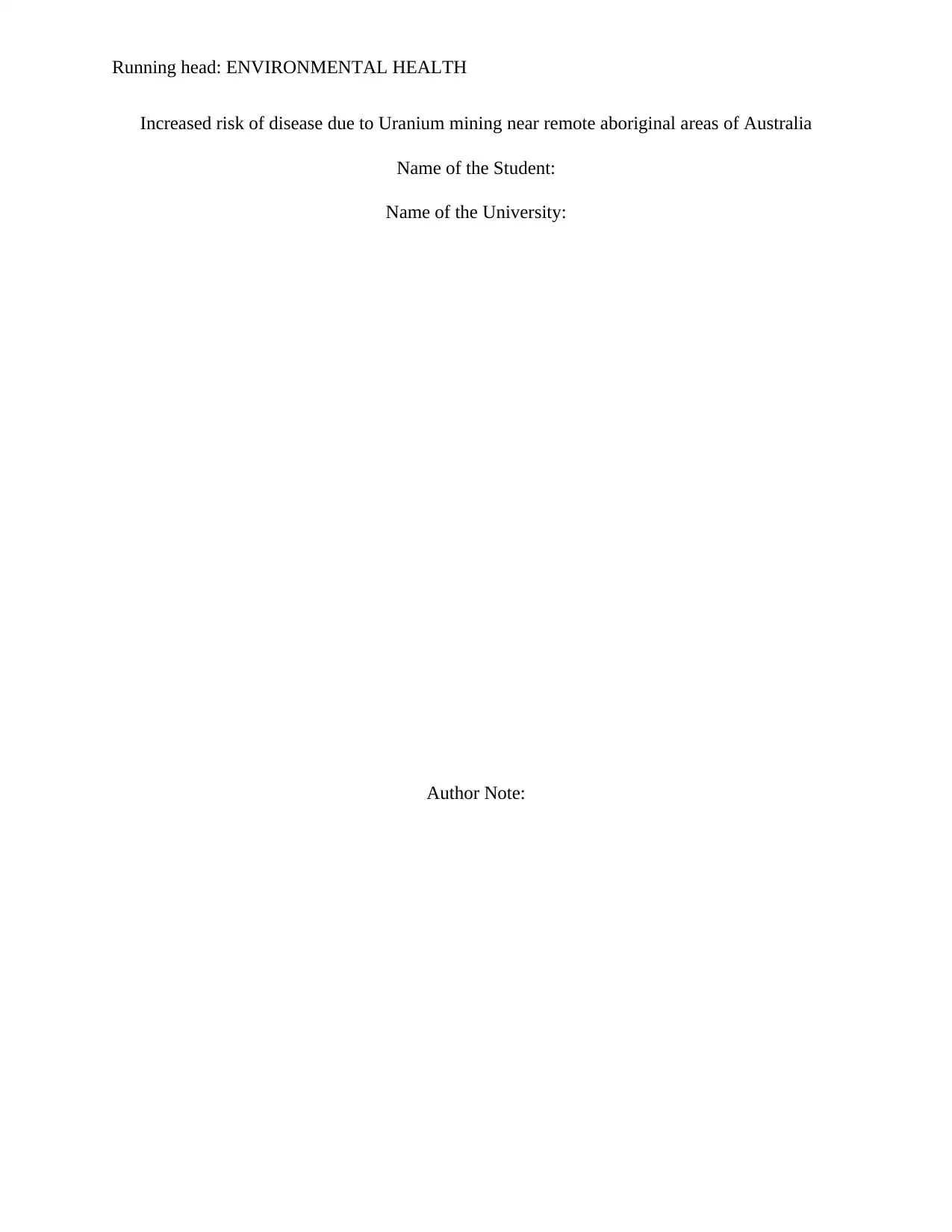
Running head: ENVIRONMENTAL HEALTH
Increased risk of disease due to Uranium mining near remote aboriginal areas of Australia
Name of the Student:
Name of the University:
Author Note:
Increased risk of disease due to Uranium mining near remote aboriginal areas of Australia
Name of the Student:
Name of the University:
Author Note:
Paraphrase This Document
Need a fresh take? Get an instant paraphrase of this document with our AI Paraphraser
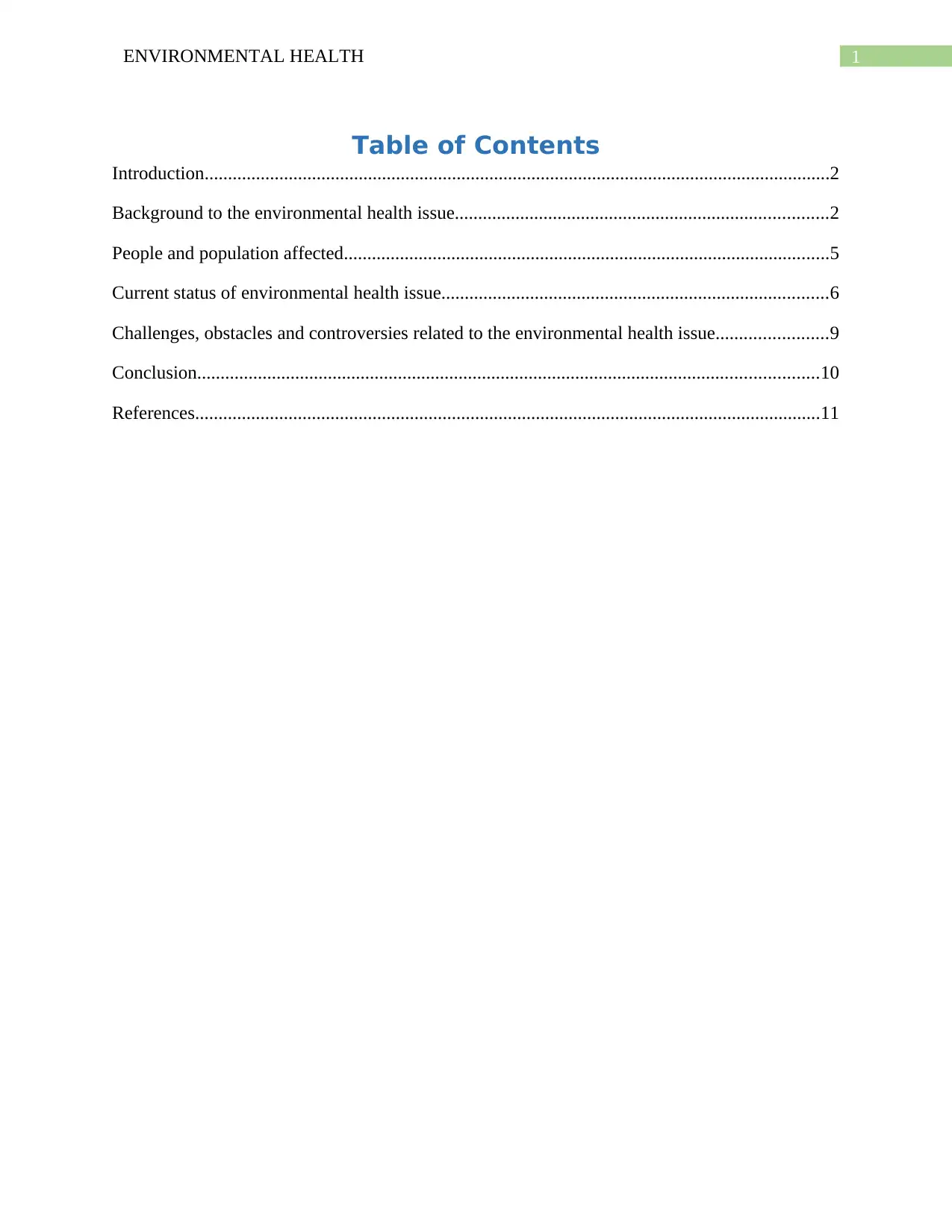
1ENVIRONMENTAL HEALTH
Table of Contents
Introduction......................................................................................................................................2
Background to the environmental health issue................................................................................2
People and population affected........................................................................................................5
Current status of environmental health issue...................................................................................6
Challenges, obstacles and controversies related to the environmental health issue........................9
Conclusion.....................................................................................................................................10
References......................................................................................................................................11
Table of Contents
Introduction......................................................................................................................................2
Background to the environmental health issue................................................................................2
People and population affected........................................................................................................5
Current status of environmental health issue...................................................................................6
Challenges, obstacles and controversies related to the environmental health issue........................9
Conclusion.....................................................................................................................................10
References......................................................................................................................................11
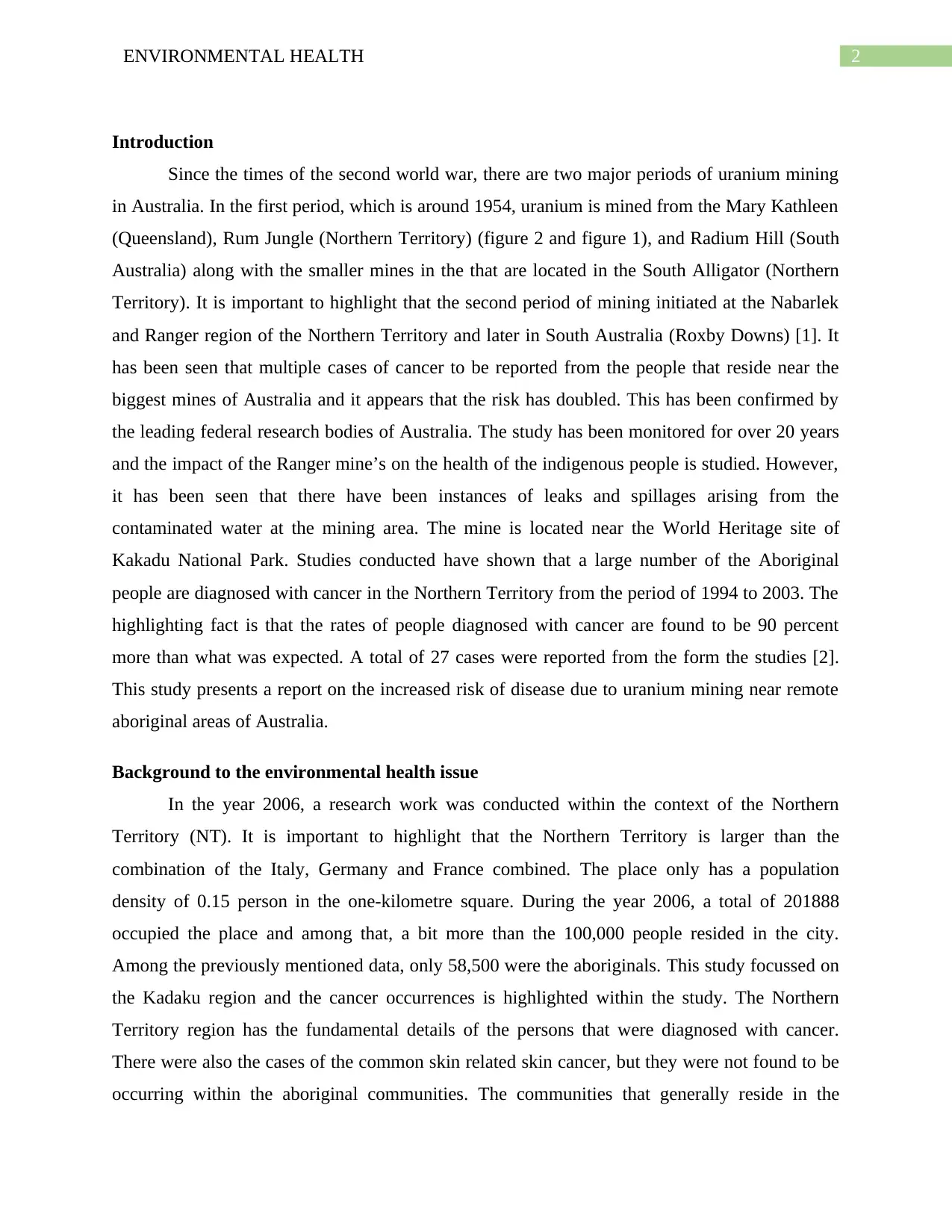
2ENVIRONMENTAL HEALTH
Introduction
Since the times of the second world war, there are two major periods of uranium mining
in Australia. In the first period, which is around 1954, uranium is mined from the Mary Kathleen
(Queensland), Rum Jungle (Northern Territory) (figure 2 and figure 1), and Radium Hill (South
Australia) along with the smaller mines in the that are located in the South Alligator (Northern
Territory). It is important to highlight that the second period of mining initiated at the Nabarlek
and Ranger region of the Northern Territory and later in South Australia (Roxby Downs) [1]. It
has been seen that multiple cases of cancer to be reported from the people that reside near the
biggest mines of Australia and it appears that the risk has doubled. This has been confirmed by
the leading federal research bodies of Australia. The study has been monitored for over 20 years
and the impact of the Ranger mine’s on the health of the indigenous people is studied. However,
it has been seen that there have been instances of leaks and spillages arising from the
contaminated water at the mining area. The mine is located near the World Heritage site of
Kakadu National Park. Studies conducted have shown that a large number of the Aboriginal
people are diagnosed with cancer in the Northern Territory from the period of 1994 to 2003. The
highlighting fact is that the rates of people diagnosed with cancer are found to be 90 percent
more than what was expected. A total of 27 cases were reported from the form the studies [2].
This study presents a report on the increased risk of disease due to uranium mining near remote
aboriginal areas of Australia.
Background to the environmental health issue
In the year 2006, a research work was conducted within the context of the Northern
Territory (NT). It is important to highlight that the Northern Territory is larger than the
combination of the Italy, Germany and France combined. The place only has a population
density of 0.15 person in the one-kilometre square. During the year 2006, a total of 201888
occupied the place and among that, a bit more than the 100,000 people resided in the city.
Among the previously mentioned data, only 58,500 were the aboriginals. This study focussed on
the Kadaku region and the cancer occurrences is highlighted within the study. The Northern
Territory region has the fundamental details of the persons that were diagnosed with cancer.
There were also the cases of the common skin related skin cancer, but they were not found to be
occurring within the aboriginal communities. The communities that generally reside in the
Introduction
Since the times of the second world war, there are two major periods of uranium mining
in Australia. In the first period, which is around 1954, uranium is mined from the Mary Kathleen
(Queensland), Rum Jungle (Northern Territory) (figure 2 and figure 1), and Radium Hill (South
Australia) along with the smaller mines in the that are located in the South Alligator (Northern
Territory). It is important to highlight that the second period of mining initiated at the Nabarlek
and Ranger region of the Northern Territory and later in South Australia (Roxby Downs) [1]. It
has been seen that multiple cases of cancer to be reported from the people that reside near the
biggest mines of Australia and it appears that the risk has doubled. This has been confirmed by
the leading federal research bodies of Australia. The study has been monitored for over 20 years
and the impact of the Ranger mine’s on the health of the indigenous people is studied. However,
it has been seen that there have been instances of leaks and spillages arising from the
contaminated water at the mining area. The mine is located near the World Heritage site of
Kakadu National Park. Studies conducted have shown that a large number of the Aboriginal
people are diagnosed with cancer in the Northern Territory from the period of 1994 to 2003. The
highlighting fact is that the rates of people diagnosed with cancer are found to be 90 percent
more than what was expected. A total of 27 cases were reported from the form the studies [2].
This study presents a report on the increased risk of disease due to uranium mining near remote
aboriginal areas of Australia.
Background to the environmental health issue
In the year 2006, a research work was conducted within the context of the Northern
Territory (NT). It is important to highlight that the Northern Territory is larger than the
combination of the Italy, Germany and France combined. The place only has a population
density of 0.15 person in the one-kilometre square. During the year 2006, a total of 201888
occupied the place and among that, a bit more than the 100,000 people resided in the city.
Among the previously mentioned data, only 58,500 were the aboriginals. This study focussed on
the Kadaku region and the cancer occurrences is highlighted within the study. The Northern
Territory region has the fundamental details of the persons that were diagnosed with cancer.
There were also the cases of the common skin related skin cancer, but they were not found to be
occurring within the aboriginal communities. The communities that generally reside in the
⊘ This is a preview!⊘
Do you want full access?
Subscribe today to unlock all pages.

Trusted by 1+ million students worldwide
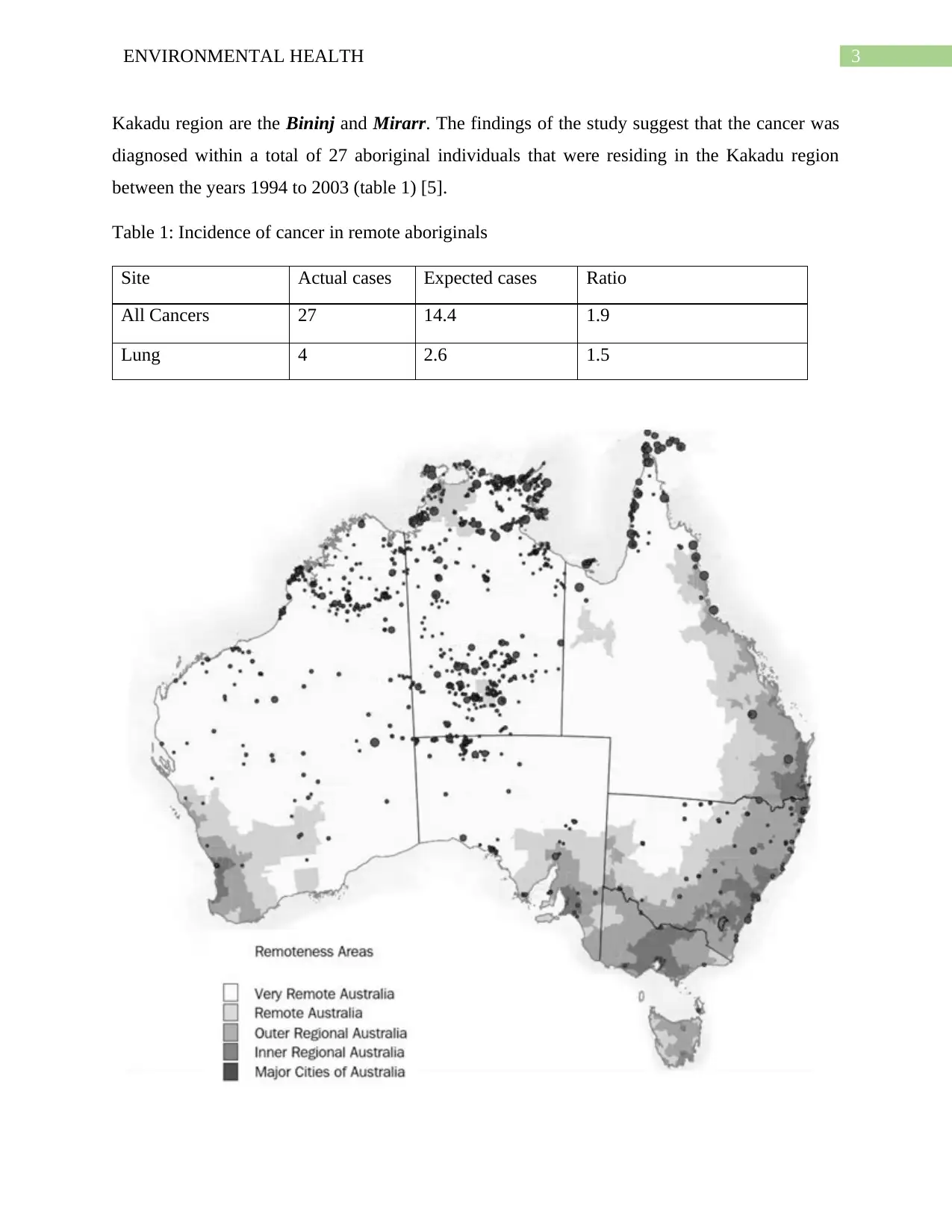
3ENVIRONMENTAL HEALTH
Kakadu region are the Bininj and Mirarr. The findings of the study suggest that the cancer was
diagnosed within a total of 27 aboriginal individuals that were residing in the Kakadu region
between the years 1994 to 2003 (table 1) [5].
Table 1: Incidence of cancer in remote aboriginals
Site Actual cases Expected cases Ratio
All Cancers 27 14.4 1.9
Lung 4 2.6 1.5
Kakadu region are the Bininj and Mirarr. The findings of the study suggest that the cancer was
diagnosed within a total of 27 aboriginal individuals that were residing in the Kakadu region
between the years 1994 to 2003 (table 1) [5].
Table 1: Incidence of cancer in remote aboriginals
Site Actual cases Expected cases Ratio
All Cancers 27 14.4 1.9
Lung 4 2.6 1.5
Paraphrase This Document
Need a fresh take? Get an instant paraphrase of this document with our AI Paraphraser
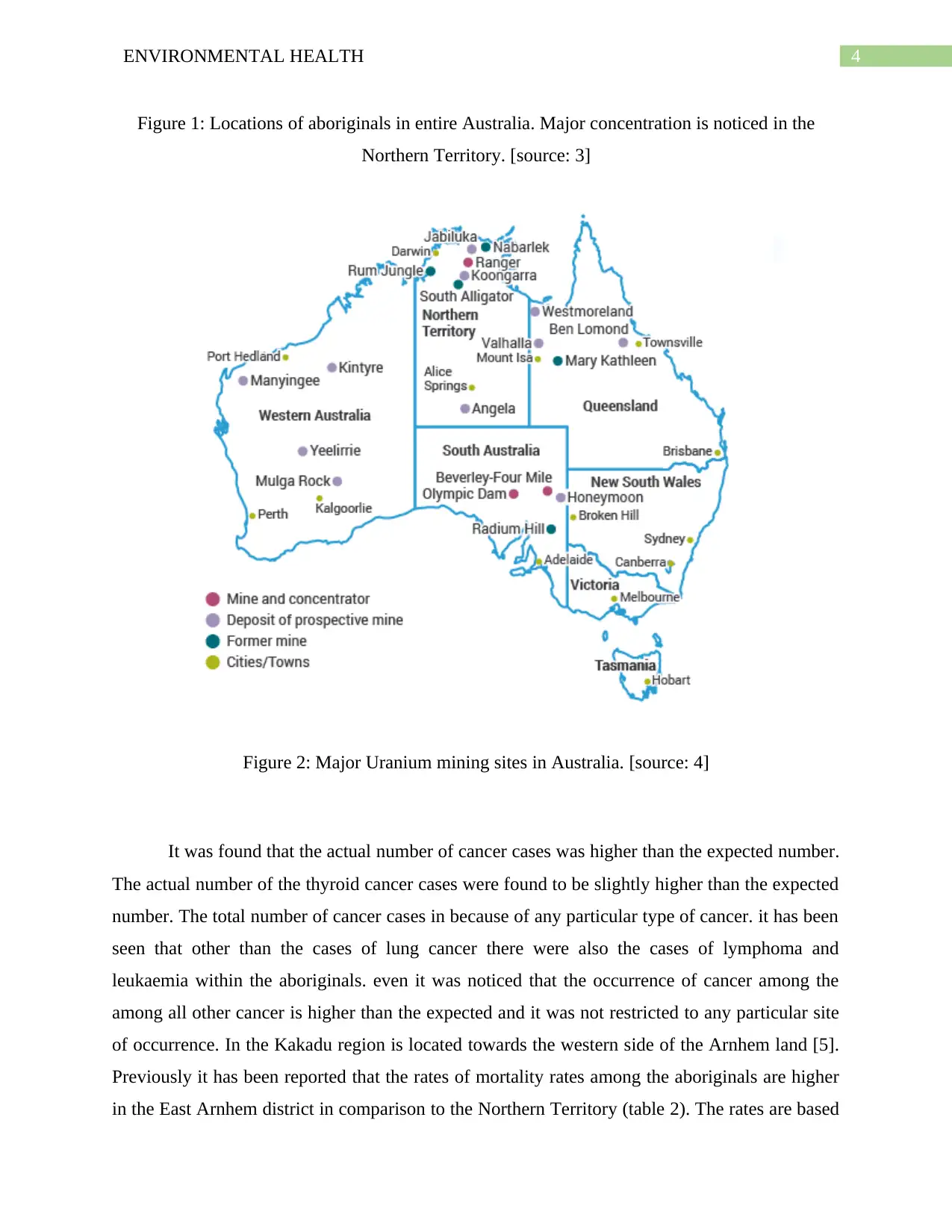
4ENVIRONMENTAL HEALTH
Figure 1: Locations of aboriginals in entire Australia. Major concentration is noticed in the
Northern Territory. [source: 3]
Figure 2: Major Uranium mining sites in Australia. [source: 4]
It was found that the actual number of cancer cases was higher than the expected number.
The actual number of the thyroid cancer cases were found to be slightly higher than the expected
number. The total number of cancer cases in because of any particular type of cancer. it has been
seen that other than the cases of lung cancer there were also the cases of lymphoma and
leukaemia within the aboriginals. even it was noticed that the occurrence of cancer among the
among all other cancer is higher than the expected and it was not restricted to any particular site
of occurrence. In the Kakadu region is located towards the western side of the Arnhem land [5].
Previously it has been reported that the rates of mortality rates among the aboriginals are higher
in the East Arnhem district in comparison to the Northern Territory (table 2). The rates are based
Figure 1: Locations of aboriginals in entire Australia. Major concentration is noticed in the
Northern Territory. [source: 3]
Figure 2: Major Uranium mining sites in Australia. [source: 4]
It was found that the actual number of cancer cases was higher than the expected number.
The actual number of the thyroid cancer cases were found to be slightly higher than the expected
number. The total number of cancer cases in because of any particular type of cancer. it has been
seen that other than the cases of lung cancer there were also the cases of lymphoma and
leukaemia within the aboriginals. even it was noticed that the occurrence of cancer among the
among all other cancer is higher than the expected and it was not restricted to any particular site
of occurrence. In the Kakadu region is located towards the western side of the Arnhem land [5].
Previously it has been reported that the rates of mortality rates among the aboriginals are higher
in the East Arnhem district in comparison to the Northern Territory (table 2). The rates are based
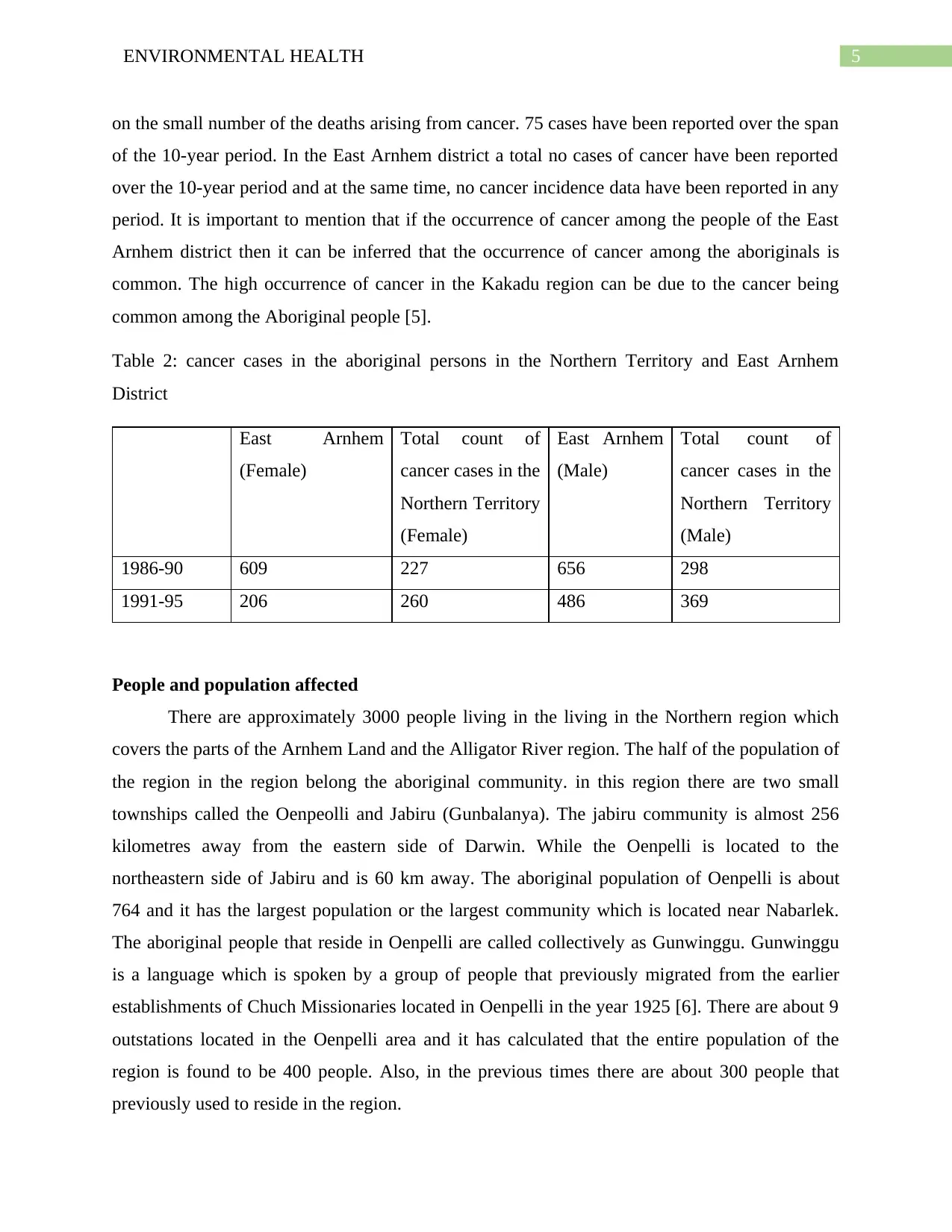
5ENVIRONMENTAL HEALTH
on the small number of the deaths arising from cancer. 75 cases have been reported over the span
of the 10-year period. In the East Arnhem district a total no cases of cancer have been reported
over the 10-year period and at the same time, no cancer incidence data have been reported in any
period. It is important to mention that if the occurrence of cancer among the people of the East
Arnhem district then it can be inferred that the occurrence of cancer among the aboriginals is
common. The high occurrence of cancer in the Kakadu region can be due to the cancer being
common among the Aboriginal people [5].
Table 2: cancer cases in the aboriginal persons in the Northern Territory and East Arnhem
District
East Arnhem
(Female)
Total count of
cancer cases in the
Northern Territory
(Female)
East Arnhem
(Male)
Total count of
cancer cases in the
Northern Territory
(Male)
1986-90 609 227 656 298
1991-95 206 260 486 369
People and population affected
There are approximately 3000 people living in the living in the Northern region which
covers the parts of the Arnhem Land and the Alligator River region. The half of the population of
the region in the region belong the aboriginal community. in this region there are two small
townships called the Oenpeolli and Jabiru (Gunbalanya). The jabiru community is almost 256
kilometres away from the eastern side of Darwin. While the Oenpelli is located to the
northeastern side of Jabiru and is 60 km away. The aboriginal population of Oenpelli is about
764 and it has the largest population or the largest community which is located near Nabarlek.
The aboriginal people that reside in Oenpelli are called collectively as Gunwinggu. Gunwinggu
is a language which is spoken by a group of people that previously migrated from the earlier
establishments of Chuch Missionaries located in Oenpelli in the year 1925 [6]. There are about 9
outstations located in the Oenpelli area and it has calculated that the entire population of the
region is found to be 400 people. Also, in the previous times there are about 300 people that
previously used to reside in the region.
on the small number of the deaths arising from cancer. 75 cases have been reported over the span
of the 10-year period. In the East Arnhem district a total no cases of cancer have been reported
over the 10-year period and at the same time, no cancer incidence data have been reported in any
period. It is important to mention that if the occurrence of cancer among the people of the East
Arnhem district then it can be inferred that the occurrence of cancer among the aboriginals is
common. The high occurrence of cancer in the Kakadu region can be due to the cancer being
common among the Aboriginal people [5].
Table 2: cancer cases in the aboriginal persons in the Northern Territory and East Arnhem
District
East Arnhem
(Female)
Total count of
cancer cases in the
Northern Territory
(Female)
East Arnhem
(Male)
Total count of
cancer cases in the
Northern Territory
(Male)
1986-90 609 227 656 298
1991-95 206 260 486 369
People and population affected
There are approximately 3000 people living in the living in the Northern region which
covers the parts of the Arnhem Land and the Alligator River region. The half of the population of
the region in the region belong the aboriginal community. in this region there are two small
townships called the Oenpeolli and Jabiru (Gunbalanya). The jabiru community is almost 256
kilometres away from the eastern side of Darwin. While the Oenpelli is located to the
northeastern side of Jabiru and is 60 km away. The aboriginal population of Oenpelli is about
764 and it has the largest population or the largest community which is located near Nabarlek.
The aboriginal people that reside in Oenpelli are called collectively as Gunwinggu. Gunwinggu
is a language which is spoken by a group of people that previously migrated from the earlier
establishments of Chuch Missionaries located in Oenpelli in the year 1925 [6]. There are about 9
outstations located in the Oenpelli area and it has calculated that the entire population of the
region is found to be 400 people. Also, in the previous times there are about 300 people that
previously used to reside in the region.
⊘ This is a preview!⊘
Do you want full access?
Subscribe today to unlock all pages.

Trusted by 1+ million students worldwide
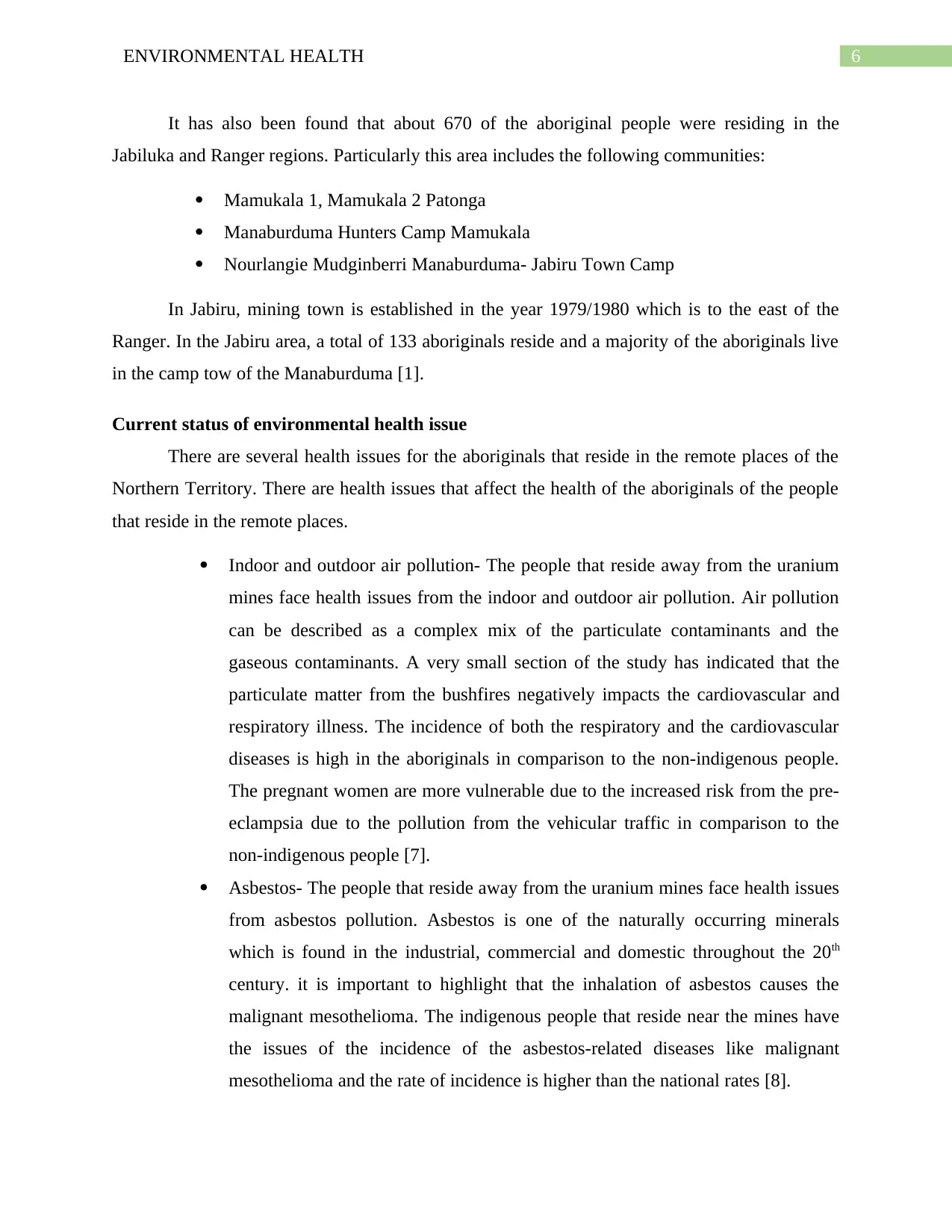
6ENVIRONMENTAL HEALTH
It has also been found that about 670 of the aboriginal people were residing in the
Jabiluka and Ranger regions. Particularly this area includes the following communities:
Mamukala 1, Mamukala 2 Patonga
Manaburduma Hunters Camp Mamukala
Nourlangie Mudginberri Manaburduma- Jabiru Town Camp
In Jabiru, mining town is established in the year 1979/1980 which is to the east of the
Ranger. In the Jabiru area, a total of 133 aboriginals reside and a majority of the aboriginals live
in the camp tow of the Manaburduma [1].
Current status of environmental health issue
There are several health issues for the aboriginals that reside in the remote places of the
Northern Territory. There are health issues that affect the health of the aboriginals of the people
that reside in the remote places.
Indoor and outdoor air pollution- The people that reside away from the uranium
mines face health issues from the indoor and outdoor air pollution. Air pollution
can be described as a complex mix of the particulate contaminants and the
gaseous contaminants. A very small section of the study has indicated that the
particulate matter from the bushfires negatively impacts the cardiovascular and
respiratory illness. The incidence of both the respiratory and the cardiovascular
diseases is high in the aboriginals in comparison to the non-indigenous people.
The pregnant women are more vulnerable due to the increased risk from the pre-
eclampsia due to the pollution from the vehicular traffic in comparison to the
non-indigenous people [7].
Asbestos- The people that reside away from the uranium mines face health issues
from asbestos pollution. Asbestos is one of the naturally occurring minerals
which is found in the industrial, commercial and domestic throughout the 20th
century. it is important to highlight that the inhalation of asbestos causes the
malignant mesothelioma. The indigenous people that reside near the mines have
the issues of the incidence of the asbestos-related diseases like malignant
mesothelioma and the rate of incidence is higher than the national rates [8].
It has also been found that about 670 of the aboriginal people were residing in the
Jabiluka and Ranger regions. Particularly this area includes the following communities:
Mamukala 1, Mamukala 2 Patonga
Manaburduma Hunters Camp Mamukala
Nourlangie Mudginberri Manaburduma- Jabiru Town Camp
In Jabiru, mining town is established in the year 1979/1980 which is to the east of the
Ranger. In the Jabiru area, a total of 133 aboriginals reside and a majority of the aboriginals live
in the camp tow of the Manaburduma [1].
Current status of environmental health issue
There are several health issues for the aboriginals that reside in the remote places of the
Northern Territory. There are health issues that affect the health of the aboriginals of the people
that reside in the remote places.
Indoor and outdoor air pollution- The people that reside away from the uranium
mines face health issues from the indoor and outdoor air pollution. Air pollution
can be described as a complex mix of the particulate contaminants and the
gaseous contaminants. A very small section of the study has indicated that the
particulate matter from the bushfires negatively impacts the cardiovascular and
respiratory illness. The incidence of both the respiratory and the cardiovascular
diseases is high in the aboriginals in comparison to the non-indigenous people.
The pregnant women are more vulnerable due to the increased risk from the pre-
eclampsia due to the pollution from the vehicular traffic in comparison to the
non-indigenous people [7].
Asbestos- The people that reside away from the uranium mines face health issues
from asbestos pollution. Asbestos is one of the naturally occurring minerals
which is found in the industrial, commercial and domestic throughout the 20th
century. it is important to highlight that the inhalation of asbestos causes the
malignant mesothelioma. The indigenous people that reside near the mines have
the issues of the incidence of the asbestos-related diseases like malignant
mesothelioma and the rate of incidence is higher than the national rates [8].
Paraphrase This Document
Need a fresh take? Get an instant paraphrase of this document with our AI Paraphraser
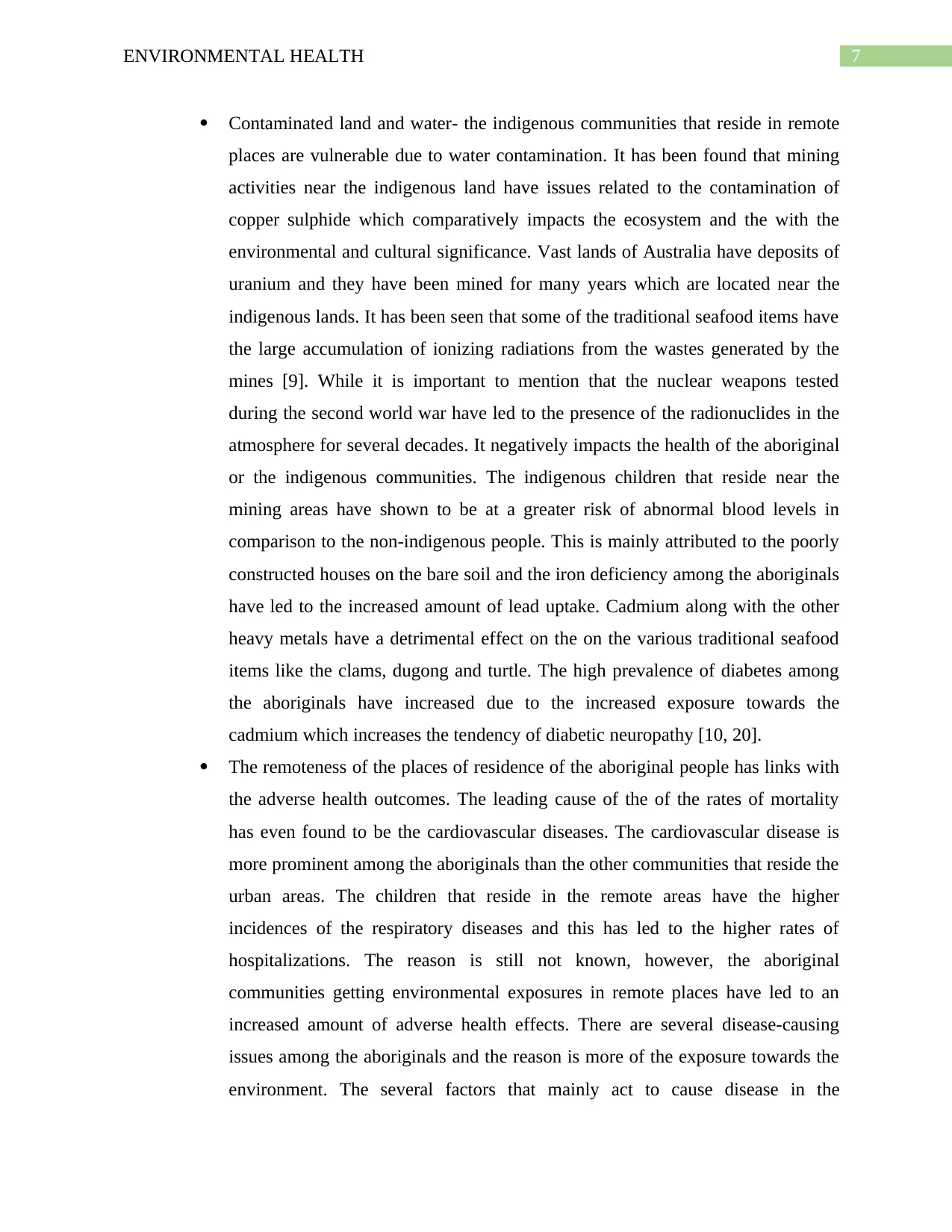
7ENVIRONMENTAL HEALTH
Contaminated land and water- the indigenous communities that reside in remote
places are vulnerable due to water contamination. It has been found that mining
activities near the indigenous land have issues related to the contamination of
copper sulphide which comparatively impacts the ecosystem and the with the
environmental and cultural significance. Vast lands of Australia have deposits of
uranium and they have been mined for many years which are located near the
indigenous lands. It has been seen that some of the traditional seafood items have
the large accumulation of ionizing radiations from the wastes generated by the
mines [9]. While it is important to mention that the nuclear weapons tested
during the second world war have led to the presence of the radionuclides in the
atmosphere for several decades. It negatively impacts the health of the aboriginal
or the indigenous communities. The indigenous children that reside near the
mining areas have shown to be at a greater risk of abnormal blood levels in
comparison to the non-indigenous people. This is mainly attributed to the poorly
constructed houses on the bare soil and the iron deficiency among the aboriginals
have led to the increased amount of lead uptake. Cadmium along with the other
heavy metals have a detrimental effect on the on the various traditional seafood
items like the clams, dugong and turtle. The high prevalence of diabetes among
the aboriginals have increased due to the increased exposure towards the
cadmium which increases the tendency of diabetic neuropathy [10, 20].
The remoteness of the places of residence of the aboriginal people has links with
the adverse health outcomes. The leading cause of the of the rates of mortality
has even found to be the cardiovascular diseases. The cardiovascular disease is
more prominent among the aboriginals than the other communities that reside the
urban areas. The children that reside in the remote areas have the higher
incidences of the respiratory diseases and this has led to the higher rates of
hospitalizations. The reason is still not known, however, the aboriginal
communities getting environmental exposures in remote places have led to an
increased amount of adverse health effects. There are several disease-causing
issues among the aboriginals and the reason is more of the exposure towards the
environment. The several factors that mainly act to cause disease in the
Contaminated land and water- the indigenous communities that reside in remote
places are vulnerable due to water contamination. It has been found that mining
activities near the indigenous land have issues related to the contamination of
copper sulphide which comparatively impacts the ecosystem and the with the
environmental and cultural significance. Vast lands of Australia have deposits of
uranium and they have been mined for many years which are located near the
indigenous lands. It has been seen that some of the traditional seafood items have
the large accumulation of ionizing radiations from the wastes generated by the
mines [9]. While it is important to mention that the nuclear weapons tested
during the second world war have led to the presence of the radionuclides in the
atmosphere for several decades. It negatively impacts the health of the aboriginal
or the indigenous communities. The indigenous children that reside near the
mining areas have shown to be at a greater risk of abnormal blood levels in
comparison to the non-indigenous people. This is mainly attributed to the poorly
constructed houses on the bare soil and the iron deficiency among the aboriginals
have led to the increased amount of lead uptake. Cadmium along with the other
heavy metals have a detrimental effect on the on the various traditional seafood
items like the clams, dugong and turtle. The high prevalence of diabetes among
the aboriginals have increased due to the increased exposure towards the
cadmium which increases the tendency of diabetic neuropathy [10, 20].
The remoteness of the places of residence of the aboriginal people has links with
the adverse health outcomes. The leading cause of the of the rates of mortality
has even found to be the cardiovascular diseases. The cardiovascular disease is
more prominent among the aboriginals than the other communities that reside the
urban areas. The children that reside in the remote areas have the higher
incidences of the respiratory diseases and this has led to the higher rates of
hospitalizations. The reason is still not known, however, the aboriginal
communities getting environmental exposures in remote places have led to an
increased amount of adverse health effects. There are several disease-causing
issues among the aboriginals and the reason is more of the exposure towards the
environment. The several factors that mainly act to cause disease in the
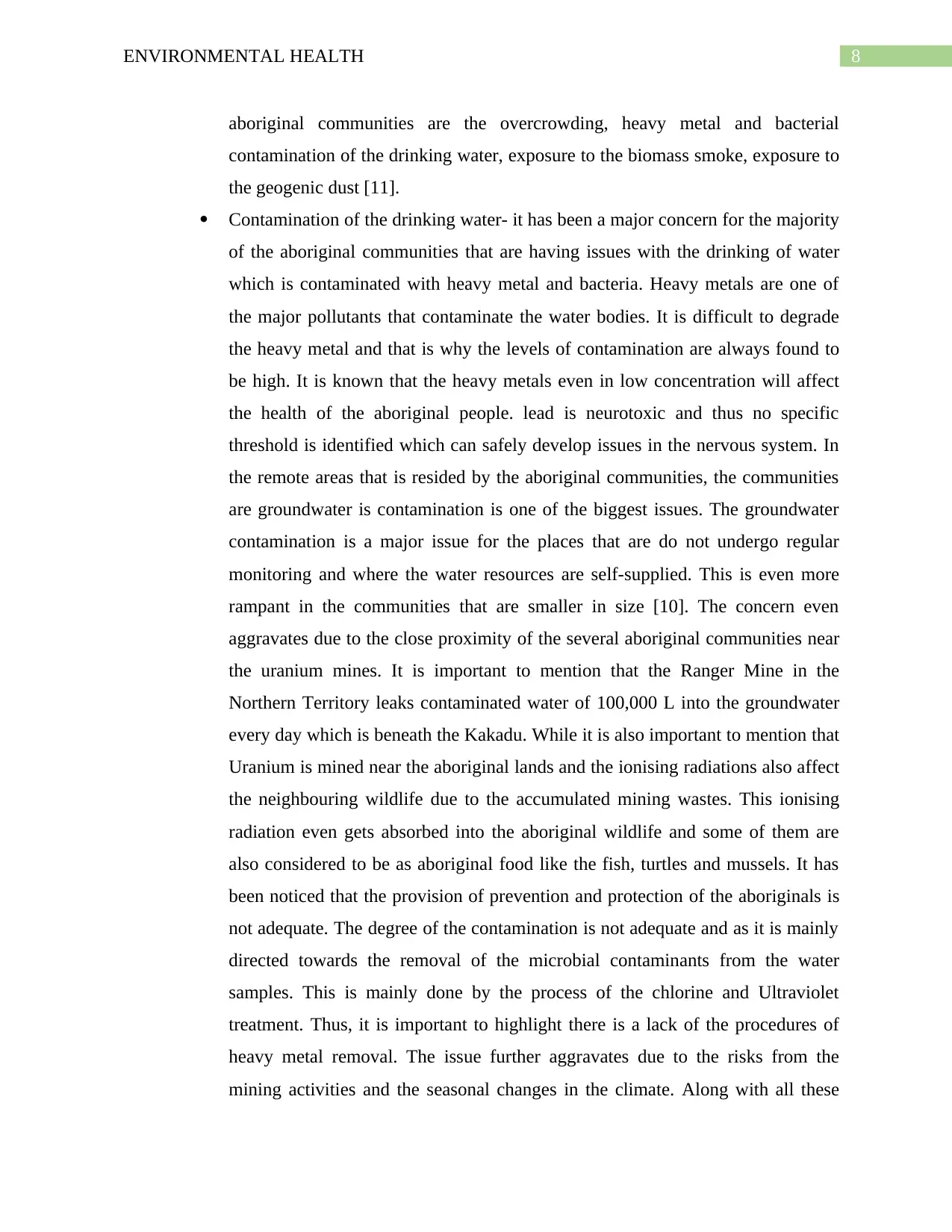
8ENVIRONMENTAL HEALTH
aboriginal communities are the overcrowding, heavy metal and bacterial
contamination of the drinking water, exposure to the biomass smoke, exposure to
the geogenic dust [11].
Contamination of the drinking water- it has been a major concern for the majority
of the aboriginal communities that are having issues with the drinking of water
which is contaminated with heavy metal and bacteria. Heavy metals are one of
the major pollutants that contaminate the water bodies. It is difficult to degrade
the heavy metal and that is why the levels of contamination are always found to
be high. It is known that the heavy metals even in low concentration will affect
the health of the aboriginal people. lead is neurotoxic and thus no specific
threshold is identified which can safely develop issues in the nervous system. In
the remote areas that is resided by the aboriginal communities, the communities
are groundwater is contamination is one of the biggest issues. The groundwater
contamination is a major issue for the places that are do not undergo regular
monitoring and where the water resources are self-supplied. This is even more
rampant in the communities that are smaller in size [10]. The concern even
aggravates due to the close proximity of the several aboriginal communities near
the uranium mines. It is important to mention that the Ranger Mine in the
Northern Territory leaks contaminated water of 100,000 L into the groundwater
every day which is beneath the Kakadu. While it is also important to mention that
Uranium is mined near the aboriginal lands and the ionising radiations also affect
the neighbouring wildlife due to the accumulated mining wastes. This ionising
radiation even gets absorbed into the aboriginal wildlife and some of them are
also considered to be as aboriginal food like the fish, turtles and mussels. It has
been noticed that the provision of prevention and protection of the aboriginals is
not adequate. The degree of the contamination is not adequate and as it is mainly
directed towards the removal of the microbial contaminants from the water
samples. This is mainly done by the process of the chlorine and Ultraviolet
treatment. Thus, it is important to highlight there is a lack of the procedures of
heavy metal removal. The issue further aggravates due to the risks from the
mining activities and the seasonal changes in the climate. Along with all these
aboriginal communities are the overcrowding, heavy metal and bacterial
contamination of the drinking water, exposure to the biomass smoke, exposure to
the geogenic dust [11].
Contamination of the drinking water- it has been a major concern for the majority
of the aboriginal communities that are having issues with the drinking of water
which is contaminated with heavy metal and bacteria. Heavy metals are one of
the major pollutants that contaminate the water bodies. It is difficult to degrade
the heavy metal and that is why the levels of contamination are always found to
be high. It is known that the heavy metals even in low concentration will affect
the health of the aboriginal people. lead is neurotoxic and thus no specific
threshold is identified which can safely develop issues in the nervous system. In
the remote areas that is resided by the aboriginal communities, the communities
are groundwater is contamination is one of the biggest issues. The groundwater
contamination is a major issue for the places that are do not undergo regular
monitoring and where the water resources are self-supplied. This is even more
rampant in the communities that are smaller in size [10]. The concern even
aggravates due to the close proximity of the several aboriginal communities near
the uranium mines. It is important to mention that the Ranger Mine in the
Northern Territory leaks contaminated water of 100,000 L into the groundwater
every day which is beneath the Kakadu. While it is also important to mention that
Uranium is mined near the aboriginal lands and the ionising radiations also affect
the neighbouring wildlife due to the accumulated mining wastes. This ionising
radiation even gets absorbed into the aboriginal wildlife and some of them are
also considered to be as aboriginal food like the fish, turtles and mussels. It has
been noticed that the provision of prevention and protection of the aboriginals is
not adequate. The degree of the contamination is not adequate and as it is mainly
directed towards the removal of the microbial contaminants from the water
samples. This is mainly done by the process of the chlorine and Ultraviolet
treatment. Thus, it is important to highlight there is a lack of the procedures of
heavy metal removal. The issue further aggravates due to the risks from the
mining activities and the seasonal changes in the climate. Along with all these
⊘ This is a preview!⊘
Do you want full access?
Subscribe today to unlock all pages.

Trusted by 1+ million students worldwide
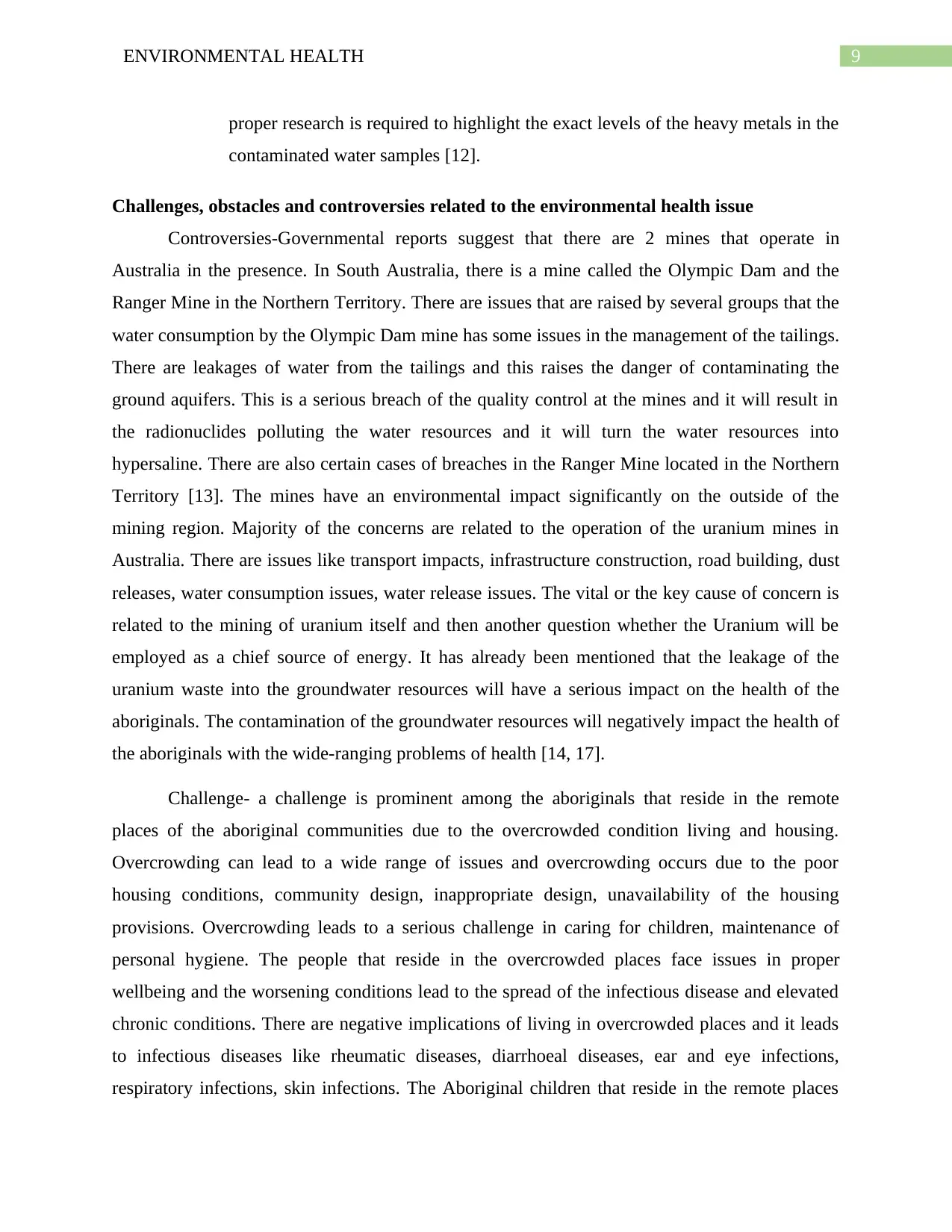
9ENVIRONMENTAL HEALTH
proper research is required to highlight the exact levels of the heavy metals in the
contaminated water samples [12].
Challenges, obstacles and controversies related to the environmental health issue
Controversies-Governmental reports suggest that there are 2 mines that operate in
Australia in the presence. In South Australia, there is a mine called the Olympic Dam and the
Ranger Mine in the Northern Territory. There are issues that are raised by several groups that the
water consumption by the Olympic Dam mine has some issues in the management of the tailings.
There are leakages of water from the tailings and this raises the danger of contaminating the
ground aquifers. This is a serious breach of the quality control at the mines and it will result in
the radionuclides polluting the water resources and it will turn the water resources into
hypersaline. There are also certain cases of breaches in the Ranger Mine located in the Northern
Territory [13]. The mines have an environmental impact significantly on the outside of the
mining region. Majority of the concerns are related to the operation of the uranium mines in
Australia. There are issues like transport impacts, infrastructure construction, road building, dust
releases, water consumption issues, water release issues. The vital or the key cause of concern is
related to the mining of uranium itself and then another question whether the Uranium will be
employed as a chief source of energy. It has already been mentioned that the leakage of the
uranium waste into the groundwater resources will have a serious impact on the health of the
aboriginals. The contamination of the groundwater resources will negatively impact the health of
the aboriginals with the wide-ranging problems of health [14, 17].
Challenge- a challenge is prominent among the aboriginals that reside in the remote
places of the aboriginal communities due to the overcrowded condition living and housing.
Overcrowding can lead to a wide range of issues and overcrowding occurs due to the poor
housing conditions, community design, inappropriate design, unavailability of the housing
provisions. Overcrowding leads to a serious challenge in caring for children, maintenance of
personal hygiene. The people that reside in the overcrowded places face issues in proper
wellbeing and the worsening conditions lead to the spread of the infectious disease and elevated
chronic conditions. There are negative implications of living in overcrowded places and it leads
to infectious diseases like rheumatic diseases, diarrhoeal diseases, ear and eye infections,
respiratory infections, skin infections. The Aboriginal children that reside in the remote places
proper research is required to highlight the exact levels of the heavy metals in the
contaminated water samples [12].
Challenges, obstacles and controversies related to the environmental health issue
Controversies-Governmental reports suggest that there are 2 mines that operate in
Australia in the presence. In South Australia, there is a mine called the Olympic Dam and the
Ranger Mine in the Northern Territory. There are issues that are raised by several groups that the
water consumption by the Olympic Dam mine has some issues in the management of the tailings.
There are leakages of water from the tailings and this raises the danger of contaminating the
ground aquifers. This is a serious breach of the quality control at the mines and it will result in
the radionuclides polluting the water resources and it will turn the water resources into
hypersaline. There are also certain cases of breaches in the Ranger Mine located in the Northern
Territory [13]. The mines have an environmental impact significantly on the outside of the
mining region. Majority of the concerns are related to the operation of the uranium mines in
Australia. There are issues like transport impacts, infrastructure construction, road building, dust
releases, water consumption issues, water release issues. The vital or the key cause of concern is
related to the mining of uranium itself and then another question whether the Uranium will be
employed as a chief source of energy. It has already been mentioned that the leakage of the
uranium waste into the groundwater resources will have a serious impact on the health of the
aboriginals. The contamination of the groundwater resources will negatively impact the health of
the aboriginals with the wide-ranging problems of health [14, 17].
Challenge- a challenge is prominent among the aboriginals that reside in the remote
places of the aboriginal communities due to the overcrowded condition living and housing.
Overcrowding can lead to a wide range of issues and overcrowding occurs due to the poor
housing conditions, community design, inappropriate design, unavailability of the housing
provisions. Overcrowding leads to a serious challenge in caring for children, maintenance of
personal hygiene. The people that reside in the overcrowded places face issues in proper
wellbeing and the worsening conditions lead to the spread of the infectious disease and elevated
chronic conditions. There are negative implications of living in overcrowded places and it leads
to infectious diseases like rheumatic diseases, diarrhoeal diseases, ear and eye infections,
respiratory infections, skin infections. The Aboriginal children that reside in the remote places
Paraphrase This Document
Need a fresh take? Get an instant paraphrase of this document with our AI Paraphraser
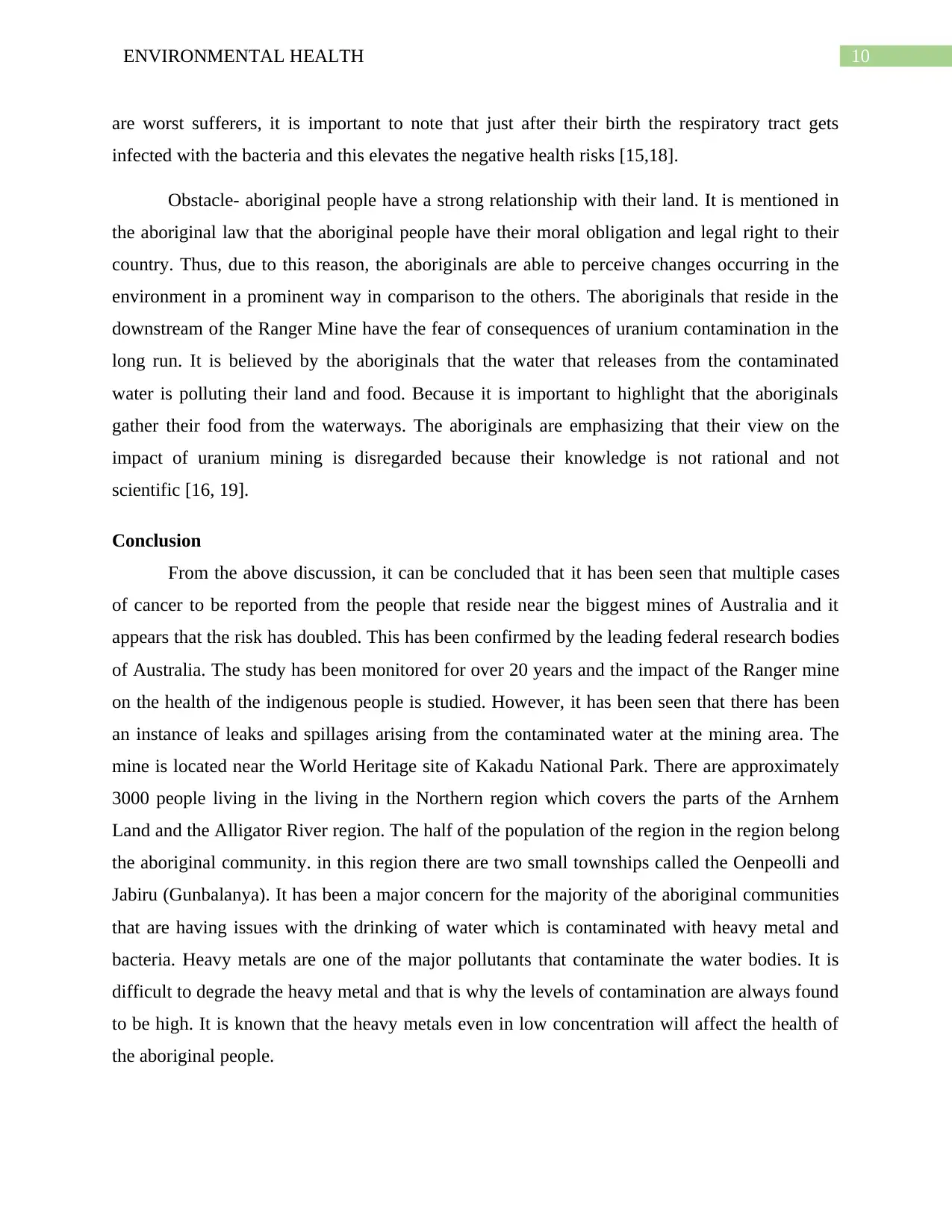
10ENVIRONMENTAL HEALTH
are worst sufferers, it is important to note that just after their birth the respiratory tract gets
infected with the bacteria and this elevates the negative health risks [15,18].
Obstacle- aboriginal people have a strong relationship with their land. It is mentioned in
the aboriginal law that the aboriginal people have their moral obligation and legal right to their
country. Thus, due to this reason, the aboriginals are able to perceive changes occurring in the
environment in a prominent way in comparison to the others. The aboriginals that reside in the
downstream of the Ranger Mine have the fear of consequences of uranium contamination in the
long run. It is believed by the aboriginals that the water that releases from the contaminated
water is polluting their land and food. Because it is important to highlight that the aboriginals
gather their food from the waterways. The aboriginals are emphasizing that their view on the
impact of uranium mining is disregarded because their knowledge is not rational and not
scientific [16, 19].
Conclusion
From the above discussion, it can be concluded that it has been seen that multiple cases
of cancer to be reported from the people that reside near the biggest mines of Australia and it
appears that the risk has doubled. This has been confirmed by the leading federal research bodies
of Australia. The study has been monitored for over 20 years and the impact of the Ranger mine
on the health of the indigenous people is studied. However, it has been seen that there has been
an instance of leaks and spillages arising from the contaminated water at the mining area. The
mine is located near the World Heritage site of Kakadu National Park. There are approximately
3000 people living in the living in the Northern region which covers the parts of the Arnhem
Land and the Alligator River region. The half of the population of the region in the region belong
the aboriginal community. in this region there are two small townships called the Oenpeolli and
Jabiru (Gunbalanya). It has been a major concern for the majority of the aboriginal communities
that are having issues with the drinking of water which is contaminated with heavy metal and
bacteria. Heavy metals are one of the major pollutants that contaminate the water bodies. It is
difficult to degrade the heavy metal and that is why the levels of contamination are always found
to be high. It is known that the heavy metals even in low concentration will affect the health of
the aboriginal people.
are worst sufferers, it is important to note that just after their birth the respiratory tract gets
infected with the bacteria and this elevates the negative health risks [15,18].
Obstacle- aboriginal people have a strong relationship with their land. It is mentioned in
the aboriginal law that the aboriginal people have their moral obligation and legal right to their
country. Thus, due to this reason, the aboriginals are able to perceive changes occurring in the
environment in a prominent way in comparison to the others. The aboriginals that reside in the
downstream of the Ranger Mine have the fear of consequences of uranium contamination in the
long run. It is believed by the aboriginals that the water that releases from the contaminated
water is polluting their land and food. Because it is important to highlight that the aboriginals
gather their food from the waterways. The aboriginals are emphasizing that their view on the
impact of uranium mining is disregarded because their knowledge is not rational and not
scientific [16, 19].
Conclusion
From the above discussion, it can be concluded that it has been seen that multiple cases
of cancer to be reported from the people that reside near the biggest mines of Australia and it
appears that the risk has doubled. This has been confirmed by the leading federal research bodies
of Australia. The study has been monitored for over 20 years and the impact of the Ranger mine
on the health of the indigenous people is studied. However, it has been seen that there has been
an instance of leaks and spillages arising from the contaminated water at the mining area. The
mine is located near the World Heritage site of Kakadu National Park. There are approximately
3000 people living in the living in the Northern region which covers the parts of the Arnhem
Land and the Alligator River region. The half of the population of the region in the region belong
the aboriginal community. in this region there are two small townships called the Oenpeolli and
Jabiru (Gunbalanya). It has been a major concern for the majority of the aboriginal communities
that are having issues with the drinking of water which is contaminated with heavy metal and
bacteria. Heavy metals are one of the major pollutants that contaminate the water bodies. It is
difficult to degrade the heavy metal and that is why the levels of contamination are always found
to be high. It is known that the heavy metals even in low concentration will affect the health of
the aboriginal people.
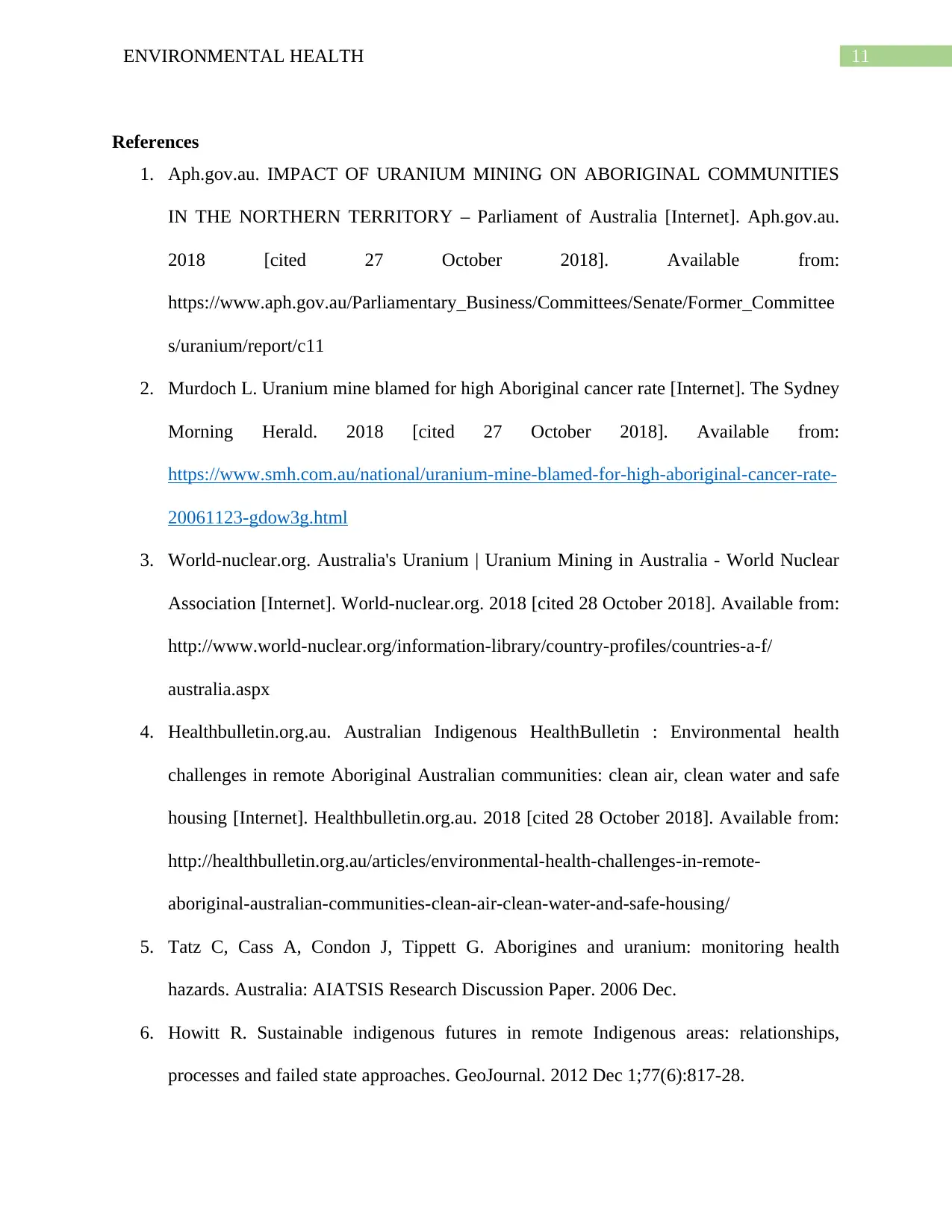
11ENVIRONMENTAL HEALTH
References
1. Aph.gov.au. IMPACT OF URANIUM MINING ON ABORIGINAL COMMUNITIES
IN THE NORTHERN TERRITORY – Parliament of Australia [Internet]. Aph.gov.au.
2018 [cited 27 October 2018]. Available from:
https://www.aph.gov.au/Parliamentary_Business/Committees/Senate/Former_Committee
s/uranium/report/c11
2. Murdoch L. Uranium mine blamed for high Aboriginal cancer rate [Internet]. The Sydney
Morning Herald. 2018 [cited 27 October 2018]. Available from:
https://www.smh.com.au/national/uranium-mine-blamed-for-high-aboriginal-cancer-rate-
20061123-gdow3g.html
3. World-nuclear.org. Australia's Uranium | Uranium Mining in Australia - World Nuclear
Association [Internet]. World-nuclear.org. 2018 [cited 28 October 2018]. Available from:
http://www.world-nuclear.org/information-library/country-profiles/countries-a-f/
australia.aspx
4. Healthbulletin.org.au. Australian Indigenous HealthBulletin : Environmental health
challenges in remote Aboriginal Australian communities: clean air, clean water and safe
housing [Internet]. Healthbulletin.org.au. 2018 [cited 28 October 2018]. Available from:
http://healthbulletin.org.au/articles/environmental-health-challenges-in-remote-
aboriginal-australian-communities-clean-air-clean-water-and-safe-housing/
5. Tatz C, Cass A, Condon J, Tippett G. Aborigines and uranium: monitoring health
hazards. Australia: AIATSIS Research Discussion Paper. 2006 Dec.
6. Howitt R. Sustainable indigenous futures in remote Indigenous areas: relationships,
processes and failed state approaches. GeoJournal. 2012 Dec 1;77(6):817-28.
References
1. Aph.gov.au. IMPACT OF URANIUM MINING ON ABORIGINAL COMMUNITIES
IN THE NORTHERN TERRITORY – Parliament of Australia [Internet]. Aph.gov.au.
2018 [cited 27 October 2018]. Available from:
https://www.aph.gov.au/Parliamentary_Business/Committees/Senate/Former_Committee
s/uranium/report/c11
2. Murdoch L. Uranium mine blamed for high Aboriginal cancer rate [Internet]. The Sydney
Morning Herald. 2018 [cited 27 October 2018]. Available from:
https://www.smh.com.au/national/uranium-mine-blamed-for-high-aboriginal-cancer-rate-
20061123-gdow3g.html
3. World-nuclear.org. Australia's Uranium | Uranium Mining in Australia - World Nuclear
Association [Internet]. World-nuclear.org. 2018 [cited 28 October 2018]. Available from:
http://www.world-nuclear.org/information-library/country-profiles/countries-a-f/
australia.aspx
4. Healthbulletin.org.au. Australian Indigenous HealthBulletin : Environmental health
challenges in remote Aboriginal Australian communities: clean air, clean water and safe
housing [Internet]. Healthbulletin.org.au. 2018 [cited 28 October 2018]. Available from:
http://healthbulletin.org.au/articles/environmental-health-challenges-in-remote-
aboriginal-australian-communities-clean-air-clean-water-and-safe-housing/
5. Tatz C, Cass A, Condon J, Tippett G. Aborigines and uranium: monitoring health
hazards. Australia: AIATSIS Research Discussion Paper. 2006 Dec.
6. Howitt R. Sustainable indigenous futures in remote Indigenous areas: relationships,
processes and failed state approaches. GeoJournal. 2012 Dec 1;77(6):817-28.
⊘ This is a preview!⊘
Do you want full access?
Subscribe today to unlock all pages.

Trusted by 1+ million students worldwide
1 out of 14
Related Documents
Your All-in-One AI-Powered Toolkit for Academic Success.
+13062052269
info@desklib.com
Available 24*7 on WhatsApp / Email
![[object Object]](/_next/static/media/star-bottom.7253800d.svg)
Unlock your academic potential
Copyright © 2020–2025 A2Z Services. All Rights Reserved. Developed and managed by ZUCOL.




